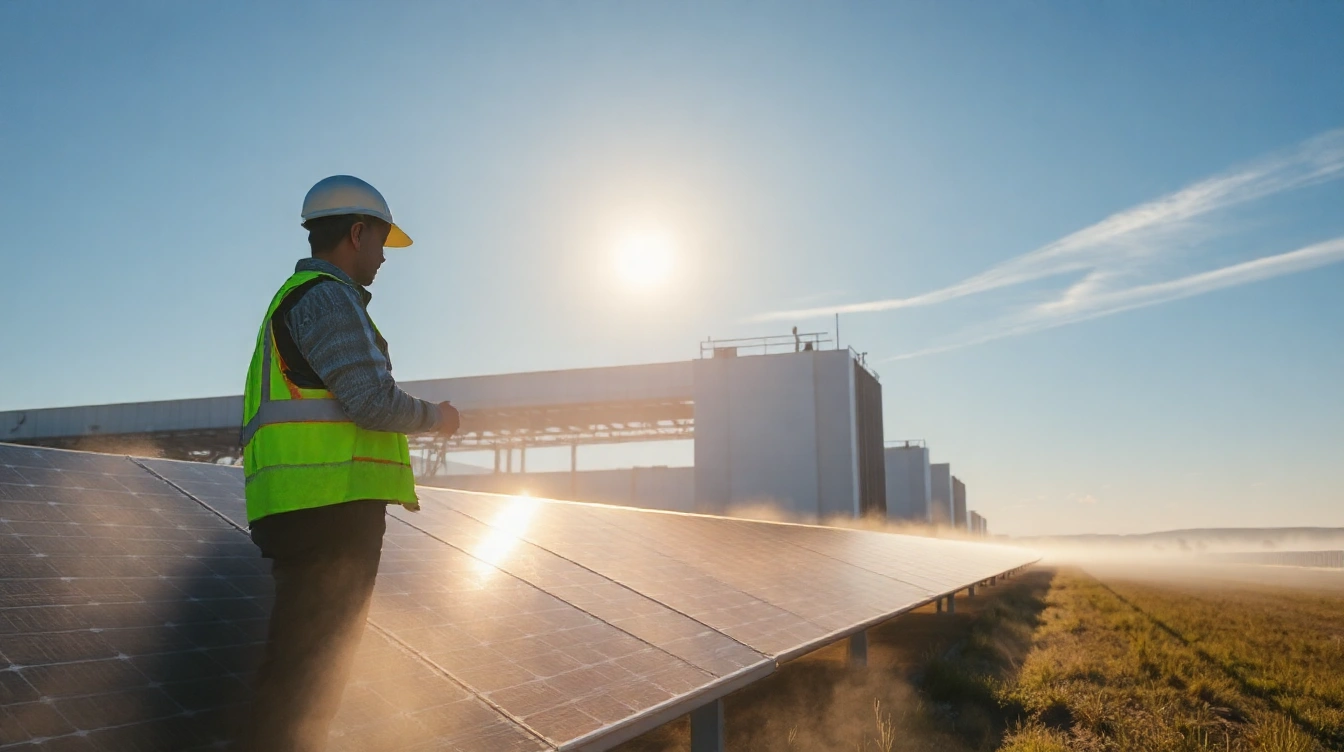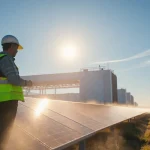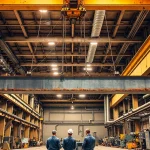Industrial solar panels transform factory energy management by cutting electricity costs and boosting operational efficiency. Solar integration streamlines workflows, reduces reliance on fluctuating energy prices, and supports sustainability goals. Real-world examples demonstrate measurable output gains and attractive returns on investment, making solar a strategic asset for factories aiming to enhance productivity and environmental performance simultaneously.
Boosting Factory Efficiency with Industrial Solar Panels
Enhancing operational performance through sustainable energy solutions
Additional reading : How Can a Liverpool-Based E-commerce Business Use A/B Testing to Improve Website Conversion Rates?
Industrial solar panels revolutionize factory efficiency by fundamentally transforming how energy is sourced and consumed. By integrating solar technology, factories can optimise their energy use, reducing reliance on traditional grids and cutting operational costs substantially. This energy optimisation not only leads to direct savings but also improves the reliability of power supply, which is crucial for maintaining seamless workflows in industrial settings.
How does solar technology streamline factory energy consumption? At its core, industrial solar panels capture sunlight and convert it into electricity, allowing factories to offset a significant portion of their energy demand. This onsite generation means less energy is drawn from external sources, enabling factories to shift their consumption patterns and reduce peak energy costs. Furthermore, solar systems often incorporate smart inverters and energy management tools, which monitor consumption in real-time, allowing for dynamic adjustment and improved energy optimisation.
This might interest you : Convenient delivery services for trusted dry cleaning in south london
The impact of solar integration on operational workflows extends beyond just energy cost savings. Real-time data from solar panels can inform maintenance schedules and predict energy availability, aligning production phases with periods of maximum solar output. This synchronization can enhance overall productivity by minimizing energy interruptions. Industrial solar panels also contribute to environmental sustainability goals, improving corporate social responsibility profiles without sacrificing operational performance.
Real-world examples underline these benefits. Factories using industrial solar panels have reported measurable increases in output, linked directly to stable energy supply and reduced downtime. For instance, manufacturers who adopted solar installations experienced a more predictable energy budget, which allowed for better planning and resource allocation. The combination of cost-effective energy and workflow enhancements illustrates why industrial solar solutions are becoming essential for future-focused factories.
For factories considering this upgrade, exploring options such as Solar Panel Installation for Factories can provide tailored solutions that address unique operational needs while maximizing energy optimisation and efficiency.
Cutting Energy Expenses and Calculating ROI
Understanding how to reduce energy costs is crucial for factories aiming to improve their bottom line and environmental footprint. Industrial solar savings come from replacing or supplementing traditional energy sources with solar-generated electricity, which typically offers much lower operational expenses once the system is installed.
When comparing traditional energy sources with solar power, the initial investment in solar panel installation can seem significant. However, the ROI analysis focuses on the payback period—the time it takes for savings on electricity bills to cover the upfront costs and ongoing operational savings. Solar energy costs are mostly fixed after installation, protecting businesses from fluctuating utility rates, which is a major economic advantage.
Key considerations in calculating ROI include:
- Initial capital expenditure for setup
- Expected lifespan and maintenance costs of solar panels
- Rate of energy consumption and local electricity prices
Financial benefits from industrial solar savings are evident in various case studies where factories report a reduction in energy expenses by up to 30-50%. Over the long term, these savings translate into substantial improvements in profitability. Moreover, stable energy costs contribute to more predictable budgeting and increased competitiveness.
For factories seeking to implement solar power, exploring tailored solutions with expert guidance on Solar Panel Installation for Factories can optimize both energy savings and ROI, making the transition financially viable and strategically beneficial.
Enhancing Sustainability and Meeting Green Goals
Increasing sustainability in industrial operations is essential for factories aiming to align with modern green initiatives. By adopting solar energy solutions, factories can significantly lower their carbon footprint. This results from replacing or supplementing traditional energy sources with clean, renewable solar power, which reduces greenhouse gas emissions and lessens environmental impact.
How does solar power adoption reduce a factory’s carbon footprint? It involves generating electricity on-site from sunlight, which requires no fossil fuels, thereby cutting down on carbon dioxide and other harmful emissions produced by conventional power plants. This transition contributes directly to the factory’s environmental benefits, enhancing air quality and supporting global climate efforts.
Moreover, many environmental regulations now mandate strict emission standards. Factories that implement solar panels demonstrate compliance, avoiding costly fines and improving their standing with regulatory bodies. The use of solar energy thus supports long-term adherence to evolving regulations, making it a strategic move for manufacturers.
By leading green efforts through solar technology, factories can position themselves as eco-friendly industry leaders. This not only fulfills corporate social responsibility but also attracts customers and partners committed to sustainability.
Types of Solar Panels Suited for Factory Applications
Understanding the types of solar panels available is crucial for optimizing factory solar systems. Factories typically choose from three main technologies: monocrystalline, polycrystalline, and thin-film solar panels. Each type offers distinct advantages and challenges that influence their suitability for different factory environments.
Monocrystalline solar panels are known for their high efficiency and sleek design. Their uniform black appearance results from single-crystal silicon, making them ideal for factories with limited roof space seeking maximum power output. However, they tend to be more expensive upfront compared to other types.
Polycrystalline solar panels are a popular choice due to their cost-effectiveness. Made from silicon crystals melted together, they have a blue, speckled appearance and generally lower efficiency than monocrystalline panels. Factories with ample roof area and moderate energy demands often benefit from these panels’ balance of performance and price.
Thin-film solar panels use layers of photovoltaic material on a substrate, providing flexibility and lightweight design. They perform better in low-light conditions and heat but generally have lower efficiency and a larger installation footprint. This technology suits factories with unconventional roof shapes or where weight constraints are a concern.
Choosing the right factory solar systems involves evaluating factors such as available roof area, energy requirements, budget, and environmental conditions like temperature and shading. For example, a factory located in a sunny region with high electricity consumption might lean toward monocrystalline panels for maximum efficiency. In contrast, a factory in a cooler or shaded environment may find thin-film technology advantageous.
Overall, the technology choice impacts installation costs, energy yield, and system longevity. To maximize return on investment, factory managers should weigh these aspects carefully when selecting solar panels, ensuring alignment with operational needs and sustainability goals.
Securing Government Incentives and Financing Options
Understanding solar incentives is crucial for any factory considering industrial solar panel installation. Governments worldwide offer various government grants and subsidies designed to lower the initial cost of solar projects. These incentives often take the form of tax credits, rebates, or direct funding, significantly improving the economic feasibility of solar investments.
What are the key government subsidies available? Typically, these include federal and state tax credits such as the Investment Tax Credit (ITC) in many regions that allow businesses to deduct a percentage of their solar installation costs from their tax liabilities. Additionally, grant programs may be available to support innovative or large-scale solar projects, further reducing financial barriers.
How do these incentives impact project feasibility and upfront costs? They can reduce the upfront capital required by a substantial margin, sometimes by 30% or more, making solar panel installation more accessible to companies with budget constraints. This helps shorten the payback period and improves return on investment (ROI).
When it comes to industrial solar financing, various structures exist. Factories can explore options such as:
- Power Purchase Agreements (PPAs), where a third party owns the system while the factory pays for the electricity generated.
- Solar leases, which allow use of the system for a fixed monthly fee.
- Traditional loans with favorable terms enabled by government programs.
Partnering with experienced solar providers is also beneficial, as they often assist in navigating incentive applications and recommend financing schemes tailored to the factory’s needs. This collaborative approach ensures that businesses maximize all available solar incentives, reducing barriers and accelerating clean energy adoption.
Implementation and Installation Considerations
Understanding the essentials of solar installation for factories is key to maximizing efficiency and long-term savings.
Assessing the factory energy needs begins by analyzing current consumption patterns and peak demand periods. This evaluation ensures the solar setup matches the factory’s specific power requirements, preventing oversizing or undersizing the system. Equally important is a thorough site suitability study. Factors like roof orientation, shading, and available space directly influence system output and placement options.
The key steps in a successful factory solar setup include detailed project planning, system design tailored to operational workflows, and selecting appropriate solar panels and inverters. Early collaboration between engineers, installers, and factory management helps align the installation timeline with production schedules, minimizing disruptions.
Navigating local regulations is critical. Permissions for solar installation often require compliance with building codes and environmental standards, as well as coordination with utility providers to ensure smooth grid connection. Understanding interconnection policies and incentives during the planning phase can streamline approvals.
By carefully considering these elements in the project plan, factories can secure a reliable, cost-effective solar installation that meets their energy needs while adhering to all regulatory requirements.
Maintenance and Operational Best Practices
Maintaining solar panel systems in factories demands consistent solar panel maintenance to sustain optimal performance. Routine maintenance tasks, such as cleaning panels to remove dust and debris and inspecting for physical damage, significantly enhance operational efficiency. Neglecting these tasks can cause a reduction in power output and accelerate wear.
Performance monitoring plays a vital role in maintaining system health. Employing digital monitoring tools allows factory operators to track real-time system output, identify anomalies early, and address issues promptly. These tools provide precise data on energy generation, enabling adjustments that maximise uptime and overall operational efficiency.
Additionally, scheduled inspections of electrical connections and inverter functionality ensure the longevity and reliability of solar panel installations. By implementing a comprehensive solar panel maintenance strategy, factories can safeguard their investments, maintain steady energy production, and reduce costly downtime.
Projected Long-Term Benefits for Factories
Long-term benefits from adopting solar energy in factories include significant factory savings and enhanced operational resilience. Over time, solar panel installations reduce dependence on fluctuating energy markets, providing a stable, predictable energy cost structure. This translates directly into substantial financial savings, as factories can avoid the rising prices associated with traditional energy sources.
Furthermore, embracing solar power strengthens a factory’s competitive positioning. As industries move toward sustainability, companies with solar infrastructure can leverage their green credentials, attracting environmentally conscious clients and partners. This proactive approach also aligns with future regulations that may incentivize or require clean energy use.
In adapting operations for upcoming energy market trends, solar adoption offers flexibility. Factories can integrate energy storage solutions to maintain uptime during grid outages, enhancing operational resilience. They also gain independence, reducing vulnerability to supply disruptions and price shocks. These factors together ensure that factories are better prepared for the evolving energy landscape, securing both their financial health and their market stance.











